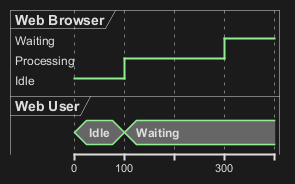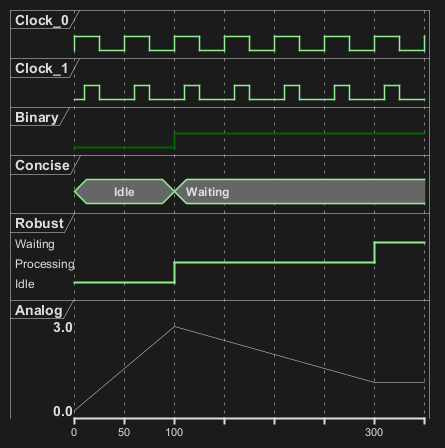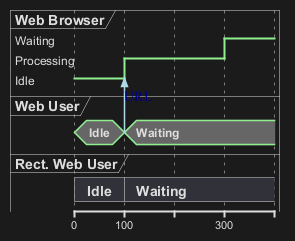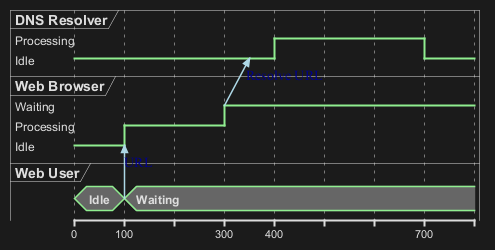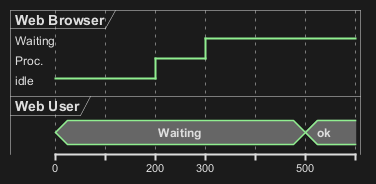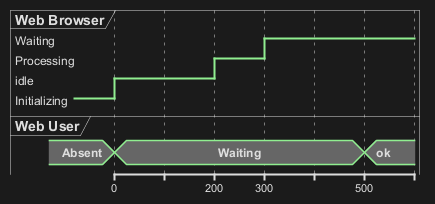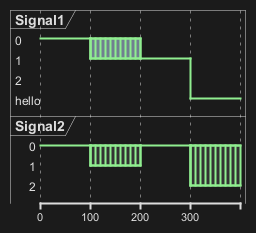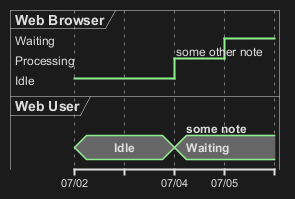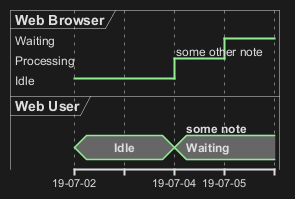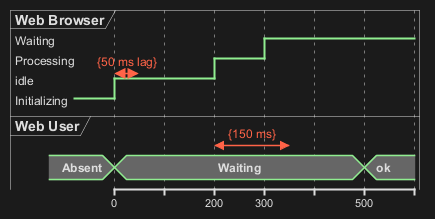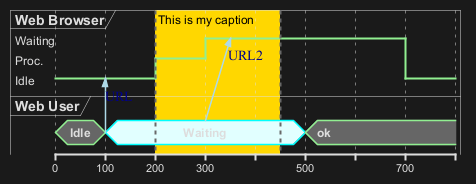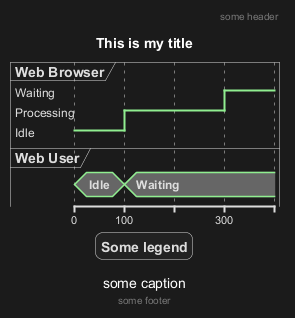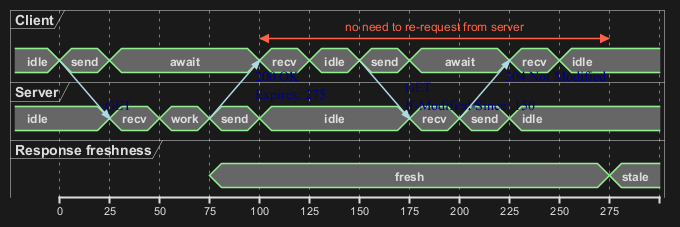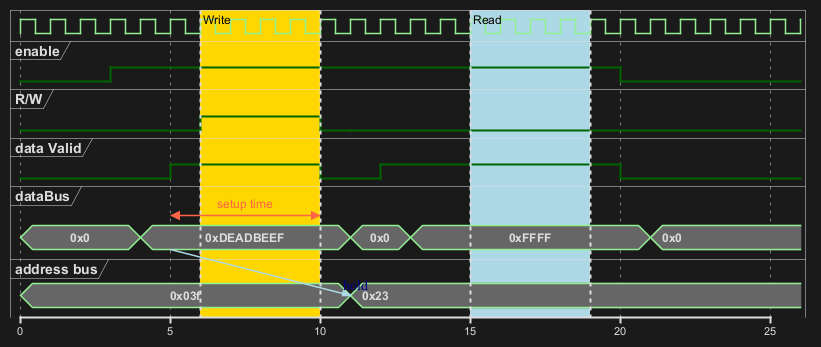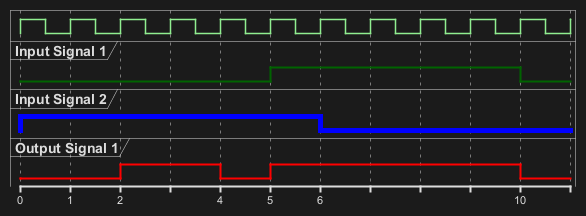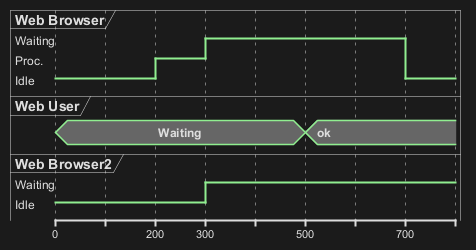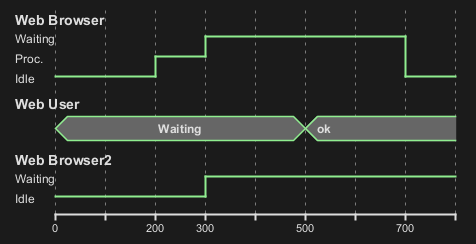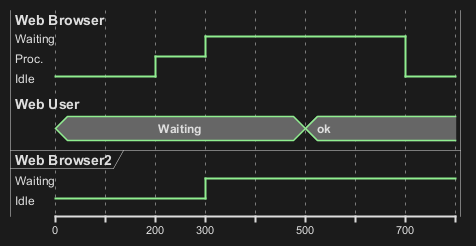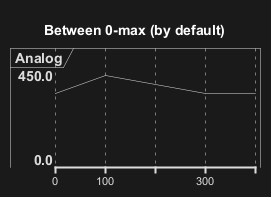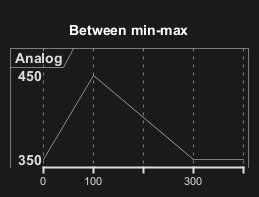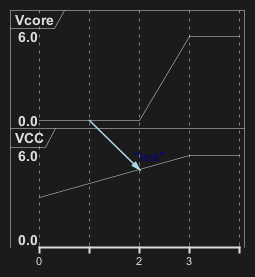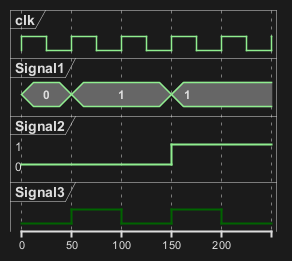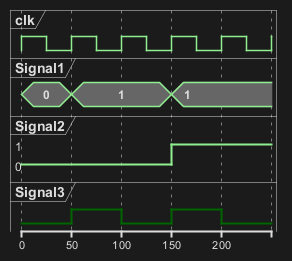Ein
Timing-Diagramm in der UML ist eine spezielle Art von
Interaktionsdiagramm, das die
zeitlichen Beschränkungen eines Systems visualisiert. Es konzentriert sich auf die
chronologische Reihenfolge von Ereignissen und zeigt, wie verschiedene Objekte im Laufe der Zeit miteinander interagieren.
Zeitdiagramme sind besonders in
Echtzeitsystemen und
eingebetteten Systemen nützlich, um das Verhalten von Objekten über einen bestimmten Zeitraum hinweg zu verstehen.
Schlüsselwörter steuern die Darstellung der Teilnehmer in der Grafik. Mit folgenden Schlüsselwörtern kann die Darstellung gesteuert werden:
|
Schlüsselwort
|
Beschreibung
|
analog
|
analog stellt den Statusübergang des Teilnehmers als analoges Signal dar, in dem die angegebenen Werte der Stati linear über die in der Zeitlinie gesetzten Zeitpunkte interpoliert werden.
|
binary
|
binary Lässt für den Teilnehmer zwei Status zu, zwischen denen er wechseln kann
|
clock
|
clocked stellt eine Rechtecksignal für den Teilnehmer dar.
Mit period wird die Frequenz für den Statuswechsel festgelegt (Muss-Angabe).
Mit offset kann der Startzeitpunkt des ersten Signals festgelegt werden.
Mit pulse kann die länge des Statusimpulses festgelegt werden
|
concise
|
concise ist eine vereinfachte Darstellung um einen Statusübergang eines Teilnehmers darzustellen (Eignet sich am besten für die Darstellung von Meldungssignalen).
|
robust
|
robust stellt eine Signallinie dar, welche den Übergang von verschiedenen Statusübergängen darstellt.
|
Ein Zeitpunkt eines Statuswechsels in der Zeitlinie wird mit
@ festgelegt.
Der jeweilige Status des Teilnehmers zu diesem Zeitpunkt wird mit
is definiert.
|
🎉 Copied!


|
@startuml
robust "Web Browser" as WB
concise "Web User" as WU
@0
WU is Idle
WB is Idle
@100
WU is Waiting
WB is Processing
@300
WB is Waiting
@enduml
|
|
🎉 Copied!


|
@startuml
clock "Clock_0" as C0 with period 50
clock "Clock_1" as C1 with period 50 pulse 15 offset 10
binary "Binary" as B
concise "Concise" as C
robust "Robust" as R
analog "Analog" as A
@0
C is Idle
R is Idle
A is 0
@100
B is high
C is Waiting
R is Processing
A is 3
@300
R is Waiting
A is 1
@enduml
|
[Ref. QA-14631, QA-14647 and QA-11288]
[Ref. QA-14631, QA-14647, QA-11288 and GH-2409]
WARNING
This translation need to be updated. WARNING
It's also possible to have binary and clock signal, using the following keywords:
|
🎉 Copied!


|
@startuml
clock clk with period 1
binary "Enable" as EN
@0
EN is low
@5
EN is high
@10
EN is low
@enduml
|
You can add message using the following syntax.
|
🎉 Copied!


|
@startuml
robust "Web Browser" as WB
concise "Web User" as WU
rectangle "Rect. Web User" as RWU
@0
WU is Idle
RWU is Idle
WB is Idle
@100
WU -> WB : URL
WU is Waiting
RWU is Waiting
WB is Processing
@300
WB is Waiting
@enduml
|
It is possible to use relative time with
@.
|
🎉 Copied!


|
@startuml
robust "DNS Resolver" as DNS
robust "Web Browser" as WB
concise "Web User" as WU
@0
WU is Idle
WB is Idle
DNS is Idle
@+100
WU -> WB : URL
WU is Waiting
WB is Processing
@+200
WB is Waiting
WB -> DNS@+50 : Resolve URL
@+100
DNS is Processing
@+300
DNS is Idle
@enduml
|
Instead of using absolute or relative time on an absolute time you can define a time as an anchor point by using the
as keyword and starting the name with a
:.
@XX as :<anchor point name>
|
🎉 Copied!


|
@startuml
clock clk with period 1
binary "enable" as EN
concise "dataBus" as db
@0 as :start
@5 as :en_high
@10 as :en_low
@:en_high-2 as :en_highMinus2
@:start
EN is low
db is "0x0000"
@:en_high
EN is high
@:en_low
EN is low
@:en_highMinus2
db is "0xf23a"
@:en_high+6
db is "0x0000"
@enduml
|
Rather than declare the diagram in chronological order, you can define it by participant.
|
🎉 Copied!


|
@startuml
robust "Web Browser" as WB
concise "Web User" as WU
@WB
0 is idle
+200 is Proc.
+100 is Waiting
@WU
0 is Waiting
+500 is ok
@enduml
|
You can also set a specific scale.
|
🎉 Copied!


|
@startuml
concise "Web User" as WU
scale 100 as 50 pixels
@WU
0 is Waiting
+500 is ok
@enduml
|
When using absolute Times/Dates, 1 "tick" is equivalent to 1 second.
|
🎉 Copied!


|
@startuml
concise "Season" as S
'30 days is scaled to 50 pixels
scale 2592000 as 50 pixels
@2000/11/01
S is "Winter"
@2001/02/01
S is "Spring"
@2001/05/01
S is "Summer"
@2001/08/01
S is "Fall"
@enduml
|
You can also define an inital state.
|
🎉 Copied!


|
@startuml
robust "Web Browser" as WB
concise "Web User" as WU
WB is Initializing
WU is Absent
@WB
0 is idle
+200 is Processing
+100 is Waiting
@WU
0 is Waiting
+500 is ok
@enduml
|
A signal could be in some undefined state.
Intricated or undefined robust state
|
🎉 Copied!


|
@startuml
robust "Signal1" as S1
robust "Signal2" as S2
S1 has 0,1,2,hello
S2 has 0,1,2
@0
S1 is 0
S2 is 0
@100
S1 is {0,1} #SlateGrey
S2 is {0,1}
@200
S1 is 1
S2 is 0
@300
S1 is hello
S2 is {0,2}
@enduml
|
Intricated or undefined binary state
|
🎉 Copied!


|
@startuml
clock "Clock" as C with period 2
binary "Enable" as EN
@0
EN is low
@1
EN is high
@3
EN is low
@5
EN is {low,high}
@10
EN is low
@enduml
|
[Ref. QA-11936 and QA-15933]
It is also possible to hide some state.
|
🎉 Copied!


|
@startuml
concise "Web User" as WU
@0
WU is {-}
@100
WU is A1
@200
WU is {-}
@300
WU is {hidden}
@400
WU is A3
@500
WU is {-}
@enduml
|
|
🎉 Copied!


|
@startuml
scale 1 as 50 pixels
concise state0
concise substate1
robust bit2
bit2 has HIGH,LOW
@state0
0 is 18_start
6 is s_dPause
8 is 10_data
14 is {hidden}
@substate1
0 is sSeq
4 is sPause
6 is {hidden}
8 is dSeq
12 is dPause
14 is {hidden}
@bit2
0 is HIGH
2 is LOW
4 is {hidden}
8 is HIGH
10 is LOW
12 is {hidden}
@enduml
|
[Ref. QA-12222]
It is possible to hide time axis.
|
🎉 Copied!


|
@startuml
hide time-axis
concise "Web User" as WU
WU is Absent
@WU
0 is Waiting
+500 is ok
@enduml
|
It is possible to use time or date.
|
🎉 Copied!


|
@startuml
robust "Web Browser" as WB
concise "Web User" as WU
@2019/07/02
WU is Idle
WB is Idle
@2019/07/04
WU is Waiting : some note
WB is Processing : some other note
@2019/07/05
WB is Waiting
@enduml
|
|
🎉 Copied!


|
@startuml
robust "Web Browser" as WB
concise "Web User" as WU
@1:15:00
WU is Idle
WB is Idle
@1:16:30
WU is Waiting : some note
WB is Processing : some other note
@1:17:30
WB is Waiting
@enduml
|
[Ref. QA-7019]
It is also possible to change date format.
|
🎉 Copied!


|
@startuml
robust "Web Browser" as WB
concise "Web User" as WU
use date format "YY-MM-dd"
@2019/07/02
WU is Idle
WB is Idle
@2019/07/04
WU is Waiting : some note
WB is Processing : some other note
@2019/07/05
WB is Waiting
@enduml
|
You can manage the time-axis labels.
Label on each tick (by default)
|
🎉 Copied!


|
@startuml
scale 31536000 as 40 pixels
use date format "yy-MM"
concise "OpenGL Desktop" as OD
@1992/01/01
OD is {hidden}
@1992/06/30
OD is 1.0
@1997/03/04
OD is 1.1
@1998/03/16
OD is 1.2
@2001/08/14
OD is 1.3
@2004/09/07
OD is 3.0
@2008/08/01
OD is 3.0
@2017/07/31
OD is 4.6
@enduml
|
Manual label (only when the state changes)
|
🎉 Copied!


|
@startuml
scale 31536000 as 40 pixels
manual time-axis
use date format "yy-MM"
concise "OpenGL Desktop" as OD
@1992/01/01
OD is {hidden}
@1992/06/30
OD is 1.0
@1997/03/04
OD is 1.1
@1998/03/16
OD is 1.2
@2001/08/14
OD is 1.3
@2004/09/07
OD is 3.0
@2008/08/01
OD is 3.0
@2017/07/31
OD is 4.6
@enduml
|
[Ref. GH-1020]
It is possible to display time constraints on the diagrams.
|
🎉 Copied!


|
@startuml
robust "Web Browser" as WB
concise "Web User" as WU
WB is Initializing
WU is Absent
@WB
0 is idle
+200 is Processing
+100 is Waiting
WB@0 <-> @50 : {50 ms lag}
@WU
0 is Waiting
+500 is ok
@200 <-> @+150 : {150 ms}
@enduml
|
Im Diagramm kann mit ''highlight'' ein Zeitbereich definiert werden, der farblich hervorgehoben wird.
|
🎉 Copied!


|
@startuml
robust "Web Browser" as WB
concise "Web User" as WU
@0
WU is Idle
WB is Idle
@100
WU -> WB : URL
WU is Waiting #LightCyan;line:Aqua
@200
WB is Proc.
@300
WU -> WB@350 : URL2
WB is Waiting
@+200
WU is ok
@+200
WB is Idle
highlight 200 to 450 #Gold;line:DimGrey : This is my caption
@enduml
|
[Ref. QA-10868]
WARNING
This translation need to be updated. WARNING
You can use the
note top of and
note bottom of
keywords to define notes related to a single object or participant
(available only for concise or binary object).
|
🎉 Copied!


|
@startuml
robust "Web Browser" as WB
concise "Web User" as WU
@0
WU is Idle
WB is Idle
@100
WU is Waiting
WB is Processing
note top of WU : first note\non several\nlines
note bottom of WU : second note\non several\nlines
@300
WB is Waiting
@enduml
|
[Ref. QA-6877, GH-1465]
You can optionally add a title, a header, a footer, a legend and a caption:
|
🎉 Copied!


|
@startuml
Title This is my title
header: some header
footer: some footer
legend
Some legend
end legend
caption some caption
robust "Web Browser" as WB
concise "Web User" as WU
@0
WU is Idle
WB is Idle
@100
WU is Waiting
WB is Processing
@300
WB is Waiting
@enduml
|
Thanks to
Adam Rosien for this example.
|
🎉 Copied!


|
@startuml
concise "Client" as Client
concise "Server" as Server
concise "Response freshness" as Cache
Server is idle
Client is idle
@Client
0 is send
Client -> Server@+25 : GET
+25 is await
+75 is recv
+25 is idle
+25 is send
Client -> Server@+25 : GET\nIf-Modified-Since: 150
+25 is await
+50 is recv
+25 is idle
@100 <-> @275 : no need to re-request from server
@Server
25 is recv
+25 is work
+25 is send
Server -> Client@+25 : 200 OK\nExpires: 275
+25 is idle
+75 is recv
+25 is send
Server -> Client@+25 : 304 Not Modified
+25 is idle
@Cache
75 is fresh
+200 is stale
@enduml
|
|
🎉 Copied!


|
@startuml
scale 5 as 150 pixels
clock clk with period 1
binary "enable" as en
binary "R/W" as rw
binary "data Valid" as dv
concise "dataBus" as db
concise "address bus" as addr
@6 as :write_beg
@10 as :write_end
@15 as :read_beg
@19 as :read_end
@0
en is low
db is "0x0"
addr is "0x03f"
rw is low
dv is 0
@:write_beg-3
en is high
@:write_beg-2
db is "0xDEADBEEF"
@:write_beg-1
dv is 1
@:write_beg
rw is high
@:write_end
rw is low
dv is low
@:write_end+1
rw is low
db is "0x0"
addr is "0x23"
@12
dv is high
@13
db is "0xFFFF"
@20
en is low
dv is low
@21
db is "0x0"
highlight :write_beg to :write_end #Gold:Write
highlight :read_beg to :read_end #lightBlue:Read
db@:write_beg-1 <-> @:write_end : setup time
db@:write_beg-1 -> addr@:write_end+1 : hold
@enduml
|
You can add
color.
|
🎉 Copied!


|
@startuml
concise "LR" as LR
concise "ST" as ST
LR is AtPlace #palegreen
ST is AtLoad #gray
@LR
0 is Lowering
100 is Lowered #pink
350 is Releasing
@ST
200 is Moving
@enduml
|
[Ref. QA-5776]
Without style (by default)
|
🎉 Copied!


|
@startuml
robust "Web Browser" as WB
concise "Web User" as WU
WB is Initializing
WU is Absent
@WB
0 is idle
+200 is Processing
+100 is Waiting
WB@0 <-> @50 : {50 ms lag}
@WU
0 is Waiting
+500 is ok
@200 <-> @+150 : {150 ms}
@enduml
|
With style
You can use
style to change rendering of elements.
|
🎉 Copied!


|
@startuml
<style>
timingDiagram {
document {
BackGroundColor SandyBrown
}
constraintArrow {
LineStyle 2-1
LineThickness 3
LineColor Blue
}
}
</style>
robust "Web Browser" as WB
concise "Web User" as WU
WB is Initializing
WU is Absent
@WB
0 is idle
+200 is Processing
+100 is Waiting
WB@0 <-> @50 : {50 ms lag}
@WU
0 is Waiting
+500 is ok
@200 <-> @+150 : {150 ms}
@enduml
|
[Ref. QA-14340]
You can use the
<style> tags and sterotyping to give a name to line attributes.
|
🎉 Copied!


|
@startuml
<style>
timingDiagram {
.red {
LineColor red
}
.blue {
LineColor blue
LineThickness 5
}
}
</style>
clock clk with period 1
binary "Input Signal 1" as IS1
binary "Input Signal 2" as IS2 <<blue>>
binary "Output Signal 1" as OS1 <<red>>
@0
IS1 is low
IS2 is high
OS1 is low
@2
OS1 is high
@4
OS1 is low
@5
IS1 is high
OS1 is high
@6
IS2 is low
@10
IS1 is low
OS1 is low
@enduml
|
[Ref. QA-15870]
You can use
compact command to compact the timing layout.
By default
|
🎉 Copied!


|
@startuml
robust "Web Browser" as WB
concise "Web User" as WU
robust "Web Browser2" as WB2
@0
WU is Waiting
WB is Idle
WB2 is Idle
@200
WB is Proc.
@300
WB is Waiting
WB2 is Waiting
@500
WU is ok
@700
WB is Idle
@enduml
|
Global mode with mode compact
|
🎉 Copied!


|
@startuml
mode compact
robust "Web Browser" as WB
concise "Web User" as WU
robust "Web Browser2" as WB2
@0
WU is Waiting
WB is Idle
WB2 is Idle
@200
WB is Proc.
@300
WB is Waiting
WB2 is Waiting
@500
WU is ok
@700
WB is Idle
@enduml
|
Local mode with only compact on element
|
🎉 Copied!


|
@startuml
compact robust "Web Browser" as WB
compact concise "Web User" as WU
robust "Web Browser2" as WB2
@0
WU is Waiting
WB is Idle
WB2 is Idle
@200
WB is Proc.
@300
WB is Waiting
WB2 is Waiting
@500
WU is ok
@700
WB is Idle
@enduml
|
[Ref. QA-11130]
You can scale analog signal.
Without scaling: 0-max (by default)
|
🎉 Copied!


|
@startuml
title Between 0-max (by default)
analog "Analog" as A
@0
A is 350
@100
A is 450
@300
A is 350
@enduml
|
With scaling: min-max
|
🎉 Copied!


|
@startuml
title Between min-max
analog "Analog" between 350 and 450 as A
@0
A is 350
@100
A is 450
@300
A is 350
@enduml
|
[Ref. QA-17161]
Without any customisation (by default)
|
🎉 Copied!


|
@startuml
analog "Vcore" as VDD
analog "VCC" as VCC
@0
VDD is 0
VCC is 3
@2
VDD is 0
@3
VDD is 6
VCC is 6
VDD@1 -> VCC@2 : "test"
@enduml
|
With customisation (on scale, ticks and height)
|
🎉 Copied!


|
@startuml
analog "Vcore" as VDD
analog "VCC" between -4.5 and 6.5 as VCC
VCC ticks num on multiple 3
VCC is 200 pixels height
@0
VDD is 0
VCC is 3
@2
VDD is 0
@3
VDD is 6
VCC is 6
VDD@1 -> VCC@2 : "test"
@enduml
|
[Ref. QA-11288]
Without order (by default)
|
🎉 Copied!


|
@startuml
robust "Flow rate" as rate
@0
rate is high
@5
rate is none
@6
rate is low
@enduml
|
With order
|
🎉 Copied!


|
@startuml
robust "Flow rate" as rate
rate has high,low,none
@0
rate is high
@5
rate is none
@6
rate is low
@enduml
|
With order and label
|
🎉 Copied!


|
@startuml
robust "Flow rate" as rate
rate has "35 gpm" as high
rate has "15 gpm" as low
rate has "0 gpm" as none
@0
rate is high
@5
rate is none
@6
rate is low
@enduml
|
[Ref. QA-6651]
By Clock (@clk)
|
🎉 Copied!


|
@startuml
clock "clk" as clk with period 50
concise "Signal1" as S1
robust "Signal2" as S2
binary "Signal3" as S3
@clk*0
S1 is 0
S2 is 0
@clk*1
S1 is 1
S3 is high
@clk*2
S3 is down
@clk*3
S1 is 1
S2 is 1
S3 is 1
@clk*4
S3 is down
@enduml
|
By Signal (@S)
|
🎉 Copied!


|
@startuml
clock "clk" as clk with period 50
concise "Signal1" as S1
robust "Signal2" as S2
binary "Signal3" as S3
@S1
0 is 0
50 is 1
150 is 1
@S2
0 is 0
150 is 1
@S3
50 is 1
100 is low
150 is high
200 is 0
@enduml
|
By Time (@time)
|
🎉 Copied!


|
@startuml
clock "clk" as clk with period 50
concise "Signal1" as S1
robust "Signal2" as S2
binary "Signal3" as S3
@0
S1 is 0
S2 is 0
@50
S1 is 1
S3 is 1
@100
S3 is low
@150
S1 is 1
S2 is 1
S3 is high
@200
S3 is 0
@enduml
|
[Ref. QA-9053]
|
🎉 Copied!


|
@startuml
binary "Binary Serial Data" as D
robust "Robust" as R
concise "Concise" as C
@-3
D is low: idle
R is lo: idle
C is 1: idle
@-1
D is high: start
R is hi: start
C is 0: start
@0
D is low: 1 lsb
R is lo: 1 lsb
C is 1: lsb
@1
D is high: 0
R is hi: 0
C is 0
@6
D is low: 1
R is lo: 1
C is 1
@7
D is high: 0 msb
R is hi: 0 msb
C is 0: msb
@8
D is low: stop
R is lo: stop
C is 1: stop
@0 <-> @8 : Serial data bits for ASCII "A" (Little Endian)
@enduml
|
[Ref. QA-15762, and QH-888]
